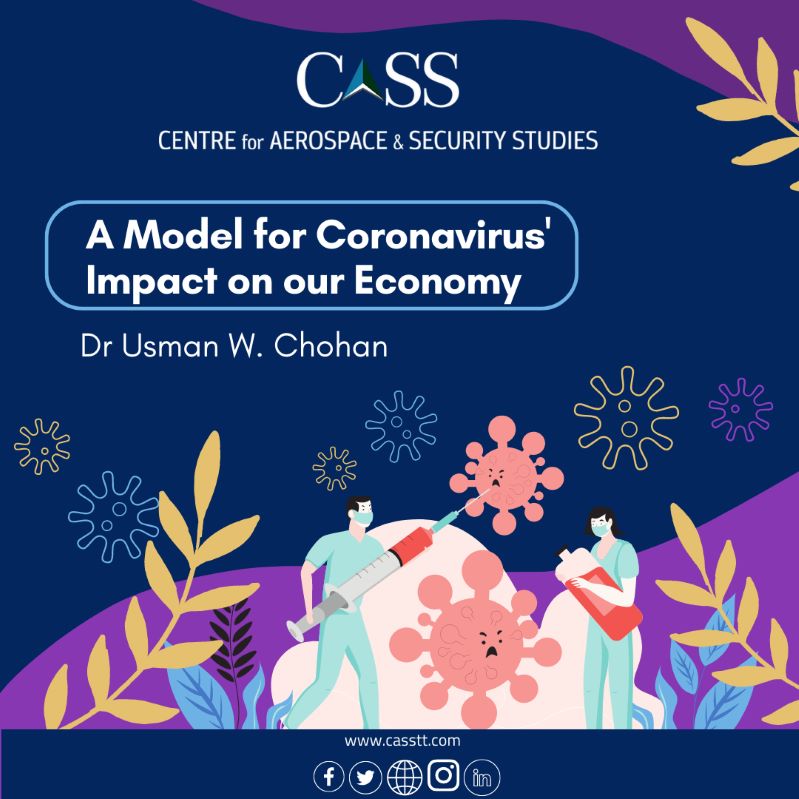As the government, private businesses, civil society, and the public at large grapple with the emerging pandemic situation across the country, an important debate has evolved in many circles regarding the degree to which the scourge of coronavirus (Covid19) might impact the Pakistani economy.
It is a cursory deduction to state that the impact will be severe and large, but it is important, even in the midst of a fluid situation, to try to assess the possible economic scenarios given the “pre-existing conditions” of our limited fiscal space, declining economic activity, exogenous pressures, and constrained resources.
To address the question in a more comprehensive manner, we constructed an aggregate expenditure model of the national economy to examine the various levers of economic activity and how vulnerable each might be to a corona contagion at multi-durational intervals of three, six, and twelve months.
Our findings were that annual GDP for the current fiscal year (FY20) might shrink by -5% year-on-year, and the final quarter (until June 2020) could contract by -10% on a quarter-to-quarter basis. This does not differ too much from other recent attempts at modelling other countries’ economies, including the United States, where quarter-on-quarter declines are estimated in the range of 8-13%.
The impacts on the following fiscal year (FY21) would be more contentious and dependent on the duration of the global and local coronavirus outbreak. A six-month extended fallout would delay economic recovery in the next fiscal year and lead to GDP contraction of -2% year-on-year in FY21, while a full-blown 12-month economic debacle (given international deflationary sluggishness and the prolonged time to a Covid19 vaccine) could set the FY21 GDP for a further -10% contraction.
Looking at the national economy, given that consumption accounts for 80% of national expenditure, it was important to disaggregate the cyclical components from the essential. The average Pakistani household spends 40% of monthly income on food and 20% on housing and utilities. Attending to food security requirements would thus be paramount, as PM Imran Khan’s judicious corona stimulus program recognizes.
We laid an emphasis in the model on the essential driver of expenditure and income: unemployment. Unemployment is the underlying determinant of the common man’s ability to eke out a living, and the daily wage class, many tens of millions of workers in size, must be attended to urgently in this regard.
While this is at the core of the government’s corona stimulus program, there is also an important role for the charitable spirit of our people and civil-society philanthropy in assuring continued food security in these trying times. In the model, for the cyclical element of monthly expenditures, including restaurants, travel etc. we modelled a near-complete short-term shut down.
Government expenditures were re-adjusted in our model in accordance with the magnitude of the announced stimulus program (Rs. 1.2 trillion). But another important aspect of expenditures, domestic and foreign debt servicing, also stood out as an issue of pressing import. As PM Imran Khan has rightly pointed out, this is an opportune time for the world (and particularly for the IMF & Paris Club) to recognize the importance of debt forgiveness to alleviate the pressures that developing countries already face.
We modelled degrees of uncertainty in private investment, which would be compensated for to a slight extent by public investment under the stimulus; albeit insufficiently so. The larger problem with private capital formation would be in the declining internal and external demand that the coronavirus lockdowns would entail.
This is where the question of exports and imports arose in the model. Given the disproportionate size of the textile group (from the cotton yarn through to finished apparels and linens) in our export make up, we drew upon recent observations from the Bangladesh economy, where the cancellation of international orders is decimating the industry. Up to 1.2 million jobs directly and 4 million jobs indirectly (in addition to 13% of GDP) are being affected in Bangladesh, as international end-user retail demand is thoroughly compressed.
Foreign remittances would also be hampered in this regard, given that our diaspora would face income constraints from labour difficulties under foreign lockdowns. This economic lifeline would thus be strangled acutely. In addition, greater pressure would befall the Rupee as investors would seek a general flight-to-safety in the dollar and emerging markets would be paid short shrift.
On the import side, we modelled some relief from the collapsing oil prices, driven by the Saudi-Russian oil price war. This is one silver lining for oil-importing countries, but oil price alleviation and larger import compression would still not compensate for export-side challenges given our narrow base of exported items.
As such, a grim picture emerged from our model for the immediate term fallout of coronavirus on the economy (in FY20). However, the duration of its socioeconomic effects would be the ultimate determinant of performance in the upcoming year (FY21), which would be driven even more so by exogenous recovery (particularly the US and China) than by local exigencies.
Pakistan is particularly indicative of the anticipated hardships that developing countries face since its economy was already in limbo before Covid19 was contracted by humans. Despite that, the Pakistani government has mobilized an action plan and arranged a stimulus program that, despite its modest size, may help to alleviate at least some of the pressure faced by the economy.
The challenges that Covid19 poses for the global economy will only be resolved by prioritizing the public health aspect of the pandemic, and a concerted effort to address imbalances in the world economy while encouraging more sustainable growth going forward. The post-pandemic world must be a better place than the one in which the virus descended.
Pakistan is a raft adrift in an ocean of turbulence, but maintaining strong anti-contagion measures (self-isolation, hygiene), assisting the financially destitute, implementing a proactive pro-poor stimulus, and keeping our heads high while bracing for the challenge ahead, all are of the utmost importance.
The writer is the Director for Economics and National Affairs at the Centre for Aerospace and Security Studies (CASS). This article was first published in The Nation newspaper. He can be reached at [email protected].





